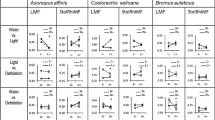Summary
The response to a single defoliation was studied on three clones of Themeda triandra collected in the short, mid, and tall grassland regions of the Serengeti National Park (Tanzania). These sites represent a gradient of decreasing grazing intensity. Growth, allocation pattern, and several morphometric traits were monitored during an 80-day period. Clipped plants of the short and medium clones fully compensated for the reduction of biomass, while plants of the tall clone showed overcompensation. During the first two weeks after clipping, clipped plants showed lower relative growth rates than unclipped ones, whereas the opposite was observed later on. Clipped plants compensated for the removal of leaf area by producing new leaves with lower specific weights and higher nitrogen content. They also produced more, smaller tillers. Although clipped plants mobilized nonstructural carbohydrates from roots and crowns, this did not account for a significant amount of growth. Relative growth rates of unclipped plants of the short clone were higher. The relative growth rate of the short clone diminished less after clipping, but also exhibited the lowest increase later. The tall clone was the most negatively affected early, but showed the highest compensation later. Compared to the other clones, the short ecotype showed many of the characteristics that defoliation induced in each individual of any clone: higher allocation to leaf area production, higher relative growth rate, higher number but smaller size of tillers, and lower leaf specific weights.
Similar content being viewed by others
References
Archer SR, Tieszen LL (1986) Plant response to defoliation: hierarchical considerations. In: Gudmundsson O (ed) Grazing research at northern latitudes. Plenum Press, New York, pp 45–59
Belsky AJ (1986) Does herbivory benefit plants? A review of the evidence. Am Nat 127:870–892
Caldwell MM, Richards JH, Johnson DA, Nowak RS, Dzurec RS (1981) Coping with herbivory: photosynthetic capacity and resource allocation in two semiarid Agropyron bunchgrasses. Oecologia (Berlin) 50:14–24
Carman JG (1985) Morphological characterization and defoliation responses of selected Schizachyrium scoparium genotypes. Am Midl Nat 114:37–43
Carman JG, Briske DD (1985) Morphologic and allozymic variation between long-term grazed and non-grazed populations of the bunchgrass Schizachyrium scoparium var. frequens. Oecologia (Berlin) 66:332–337
Causton DR, Venus JC (1981) The biometry of plant growth. Edward Arnold, London, pp 307
Coughenour MB, McNaughton SJ, Wallace LL (1985a) Shoot growth and morphometric analyses of Serengeti graminoids. Afr J Ecol 23:179–194
Coughenour MB, McNaughton SJ, Wallace LL (1985b) Response of an african graminoid (Themeda triandra Forsk.) to frequent defoliation, nitrogen, and water: a limit of adaptation to herbivory. Oecologia (Berlin) 68:105–110
Deregibus VA, Sanchez RA, Casal JJ, Trlica MJ (1985) Tillering responses to enrichment of red light beneath the canopy in a humid natural grassland. J Appl Ecol 22:199–206
Detling JK, Dyer MI, Winn DT (1979) Net photosynthesis, root respiration, and regrowth of Bouteloua gracilis following simulated grazing. Oecologia (Berlin) 41:127–134
Detling JK, Painter EL (1983) Defoliation responses of western wheatgrass populations with diverse histories of prairie dog grazing. Oecologia (Berlin) 57:65–71
Grime JP (1979) Plant strategies and vegetation processes. Wiley, New York, pp 222
Grime JP, Hunt R (1975) Relative growth-rate: its range and adaptive significance in a local flora. J Ecol 63:393–422
Hawkins CDB, Whitecross MI, Aston MJ (1986) Long-term effects on cowpea plant growth of a short-term cowpea aphid infestation. Can J Bot 64:1727–1732
Hilbert DW, Swift DM, Detling JK, Dyer MI (1981) Relative growth rates and the grazing optimization hypothesis. Oecologia (Berlin) 51:14–18
Hunt R (1982) Plant growth curves. The functional approach to growth analysis. University Park Press, Baltimore, pp 248
McNaughton SJ (1974) Developmental control of net productivity in Typha latifolia ecotypes. Ecology 55:864–869
McNaughton SJ (1983a) Compensatory plant growth as a response to herbivory. Oikos 40:329–336
McNaughton SJ (1983b) Serengeti grassland ecology: the role of composite environmental factors and contingency in community organization. Ecol Monogr 53:291–320
McNaughton SJ (1984) Grazing lawns: animals in herds, plant form, and coevolution. Am Nat 124:863–886
McNaughton SJ (1986) On plants and herbivores. Am Nat 128:765–770
McNaughton SJ, Chapin FS (1985) Effects of phosphorus nutrition and defoliation on C4 graminoids from the Serengeti plains. Ecology 66:1617–1629
McNaughton SJ, Wallace LL, Coughenour MB (1983) Plant adaptation in an ecosystem context: effects of defoliation, nitrogen, and water on growth of an African C4 sedge. Ecology 64:307–318
Mooney HA, Gulmon SL (1982) Constraints on leaf structure and function in reference to herbivory. BioScience 32:198–206
Painter EL, Detling JK (1981) Effects of defoliation on net photosynthesis and regrowth of western wheatgrass. J Range Manage 34:68–71
Richards JH, Caldwell MM (1985) Soluble carbohydrates, concurrent photosynthesis and efficiency in regrowth following defoliation: a field study with Agropyron species. J Appl Ecol 22:907–920
Risser PG (1985) Grasslands. In: Chabot BF, Mooney HA (eds) Physiological ecology of North American plant communities. Chapman and Hall, New York, pp 232–256
Ruess RW (1984) Nutrient movement and grazing: experimental effects of clipping and nitrogen source on nutrient uptake in Kyllinga nervosa. Oikos 43:183–188
SAS Institute (1982) SAS user's guide: statistics. SAS Institute, Cary, pp 584
Smith D (1969) Removing and analyzing total nonstructural carbohydrates from plant tissues. Univ Wis (Madison) Rep 41:1–11
Sokal RR, Rohlf FJ (1969) Biometry. Freeman, San Francisco, pp 776
Toft NL, McNaughton SJ, Georgiadis NJ (1987) Effects of water stress and simulated grazing on leaf elongation and water relations of an east African grass, Eustachys paspaloides. Aust J Plant Physiol 14:211–226
Wallace LL, McNaughton SJ, Coughenour MB (1984) Compensatory photosynthetic responses of three african graminoids to different fertilization, watering, and clipping regimes. Bot Gaz 145:151–156
Author information
Authors and Affiliations
Rights and permissions
About this article
Cite this article
Oesterheld, M., McNaughton, S.J. Intraspecific variation in the response of Themeda triandra to defoliation: the effect of time of recovery and growth rates on compensatory growth. Oecologia 77, 181–186 (1988). https://doi.org/10.1007/BF00379184
Received:
Issue Date:
DOI: https://doi.org/10.1007/BF00379184




